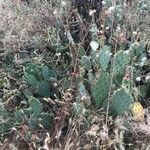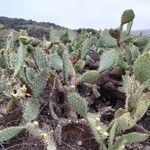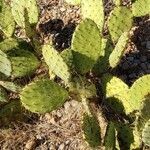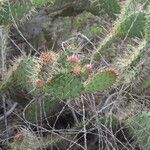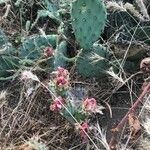Shrubs, spreading to sprawling, forming large clumps, to 1 × 1-9 m. Stem segments not disarticulating, green, flattened, elliptic to obovate to rhombic, 15-25(-40) × 6.5-14 cm, ± tuberculate, glabrous, usually glaucous; areoles 5-7(-8) per diagonal row across midstem segment, prominent, subcircular(-oval), 4-6 × 4-5 mm, enlarging in age; wool gray. Spines 4-11 per areole, in most areoles, yellow with chalky white coat, to yellow with red-brown basal portions, aging reddish gray; erect ones terete, stout, straight; abaxial ones reflexed, shorter, to 12 mm; adaxial spines spreading, longest spines 20-40 mm. Glochids moderately dense in crescent at adaxial edge of areole, merging with subapical tuft when present, yellow to red-brown, to 5 mm. Flowers: inner tepals yellow to dull red throughout, 35-45 mm; filaments yellow to orange-yellow; anthers yellow; style pink to red; stigma lobes yellow-green to green. Fruits dark red-purple throughout, obovoid, 35-50 × 30-35 mm, juicy, glabrous, spineless; areoles 22-36. Seeds gray, subcircular, warped, 3-4.5 mm diam.; girdle protruding 0.5 mm. 2n = 66.
More
A cactus. It is a sprawling shrub. It grows 30-60 cm high and spreads 30-120 cm wide. The stem segments are flattened and nearly round. They are dotted with tufts of yellow bristles and brown spines. The flowers are yellow with red centres. The fruit are red. They have several hard seeds.
